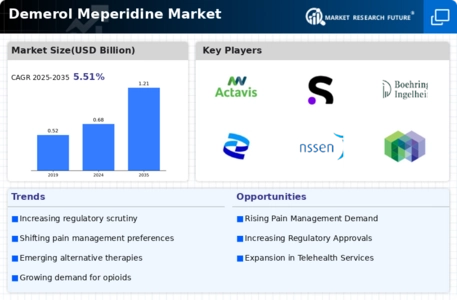Market Trends
Key Emerging Trends in the Demerol Meperidine Market
The Demerol Meperidine market, focused on the opioid analgesic drug Demerol, is undergoing notable trends influenced by factors such as changing pain management protocols, regulatory developments, and the ongoing efforts to address opioid-related concerns. These trends shape the landscape of the Demerol Meperidine market in terms of usage, regulations, and alternative pain management strategies. The market is growing in favour of safer and less addictive pain control options as opioid abuse and addiction keep becoming the concerns of the consumer. Consequently, this trend has made healthcare providers reconsider the role of Demerol Meperidine in pain management and look for non-opioid alternatives to reduce the risk of dependence. Demerol Meperidine market is being affected by regulatory pressure and introduction of opioid prescribing guidelines. With the healthcare professionals adjusting to more stringent guidelines in responsible use of opioids, more mindful approach in the prescription of Demerol, and other opioids for pain control is being taken. Opioid-sparing methods have emerged as a part of the wider trend in opioid reduction. The Demerol Meperidine market is responding to the wide use of multimodal analgesia, regional anesthesia and various other approaches that reduce the use of opioids, which indicates a comprehensive approach to pain management. Awareness about the side effects of opoid-induced and includes respiratory depression, constipation as well as the propensity for addiction are influencing the prescribing patterns within the meperidine market. The providers take these risks into account when choosing the pain management options and, therefore, promote the more balanced approach. The trends of the Demerol Meperidine market are such that patient education and monitoring form part and parcel. The healthcare providers are now focusing deeper on educating the patients about the ill effects of Demerol, providing proper usage instructions, and close monitoring of the patients to avoid any adverse effects. The market is seeing the advent of abuse-deterrent formulations of opioid drugs, including Demerol Meperidine. These formulations deter misuse by allowing the opioid to flow, in turn making it impossible to crush or otherwise manipulate the drug for immediate administration, which corresponds to efforts of reducing the opioid abuse. Technology has its part in forming the Demerol Meperidine market, through the incorporation of electronic health records (EHRs) and prescription monitoring programs. Such tools allow healthcare providers to monitor opioid prescriptions, detect possible abuse and take well-informed actions related to patient care. Research and development attempts are concentrated on the identification of new analgesics that have the better safety characteristics and with the reduced potential of abuse. This is the industry’s commitment to seeking alternative pain management solutions preserving the efficacy and reducing the risks associated with opioids like Demerol. There are global dynamics of the market of the Demerol Meperidine, where, the opioid prescription practices and regulations vary from one region to another. Comprehending and adjusting to those global nuances is getting important for pharmaceutical companies that work in the Demerol Meperidine market.
Collaborations between pharmaceutical companies, healthcare organizations, and pain management specialists are on the rise. These partnerships aim to develop comprehensive pain management solutions that go beyond opioids, incorporating a multidisciplinary approach to address the diverse needs of patients experiencing pain.


 Source: Secondary Research, Primary Research, Market Research Future Database and Analyst Review
Source: Secondary Research, Primary Research, Market Research Future Database and Analyst Review







Leave a Comment